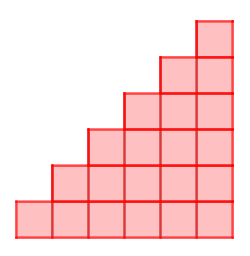Picturing triangular numbers
What do you notice about the sum of two identical triangular numbers?
Problem
Picturing Triangular Numbers printable worksheet
Triangular numbers can be represented by a triangular array of squares.

Imagine two copies of a triangular array of squares. Can you picture how to fit them together to make a rectangle? What is special about the dimensions of your rectangle?
Use the activity below to test your ideas.
What do you notice about doubling triangular numbers?
Experiment with different triangle numbers and explain what is special about the rectangles made from two identical triangle numbers.
Can you write down the dimensions of the rectangle made from two copies of the 250th triangle number? Can you use this to work out the 250th triangle number?
Check - your answer should be somewhere in this list:
29184, 31375, 586594, 908475, 2092035
Deduce a strategy for working out any triangle number.
Extension:
Consider the following numbers: $4851, 6214, 3655, 7626, 8656$.
Which are triangle numbers?
How did you decide?
Do any triangle numbers end $000$?
You may wish to try the problems Mystic Rose and Handshakes. Can you see why we chose to publish these three problems together?
You may also be interested in reading the article Clever Carl, the story of a young mathematician who came up with an efficient method for adding lots of consecutive numbers.
Getting Started
How could you describe the rectangles that are formed?
Keep a record of your results.
How might square roots help when determining whether or not a number is a triangle number?
Student Solutions
Siobhan, Ruth, Ruth and Toby from Risley Lower Grammar Primary School, Joe from Hove Park Lower School, Nathan, Dulan and Pavan from Wilson's Grammar School and Thomas from PS6 in New York noticed that:
If you double a triangular number, you get a rectangular number.
For the $n$th triangle number, the sides of the rectangle are $n$ and $n+1$.
Therefore, the $n$th triangular number can be written $n(n+1)/2$.
Using this $T_{250} = 31375$
Students from the Tower Hamlets Enriching Maths project also worked on this problem:
We worked out that the rectangle always has a length which is 1 more than the width.
So to find the nth triangle number, work out n times (n+1) and then divide by 2.
To tell if 4851 is a triangle number, we doubled it to get 9702, and then used trial and improvement to see if we could find two consecutive numbers which multiplied to give 9702.
98 and 99 work, so 4851 is the 98th triangle number.
Elise from Trentham High School sent us this complete solution to the problem.
Jinquan from The Chinese High School in Singapore explained that:
$T_{250}+T_{250}$ is $250 \times251$, and more generally $T_{n}+T_n = n(n+1)$
Hence, $T_n=n(n+1)/2$
which gives $T_{250}=31375$,
Consider $4851$.
If $4851$ is a triangular number, $9702$ can be expressed as $n(n+1)$.
By solving the quadratic equation or by estimating, we get $n = 98$, and hence $4851 = T_{98}$
In general, a number $x$ is a triangular number if and only if $n(n+1)=2x$ is solvable for positive integers of $n$.
Consider $6214$.
If it is a triangular number, $12428$ can be expressed as $n(n+1)$.
By solving the quadratic equation or by estimating, we see that there are no solutions in positive integers.
Hence $6214$ is not a triangular number.
Consider $3655$.
If it is a triangular number, $7310$ can be expressed as $n(n+1)$.
By solving the quadratic equation or by estimating, we get $n = 85$, and hence $3655 = T_{85}$
Teachers' Resources
Why do this problem?
This problem offers students an opportunity to relate numerical ideas to spatial representation, and vice versa.
The interactivity allows students to explore large triangle numbers. Visualising the combination of two identical triangle numbers can lead to an understanding of the general formula for triangle numbers.
Possible approach
This printable worksheet may be useful: Picturing Triangle Numbers.
This problem works very well in conjunction with Mystic Rose and Handshakes. The whole class could work on all three problems together, or small groups could be allocated one of the three problems to work on, and then report back to the rest of the class.
Introduce the terminology "triangle numbers" if it has not been met before, and show the pictorial representation of the fifth triangle number. Ask students to visualise how they could fit together two copies of the same triangle number to make a rectangle.
Give students time to work together in pairs to explain what happens when they combine other pairs of identical triangle numbers, keeping a record of what they do. Then bring the class together and write on the board the dimensions of the rectangles they found for different triangle numbers, using the interactivity to check.
"What is special about the dimensions of the rectangles? Why?"
"Can you write down the dimensions of the rectangle made from two copies of the 250th triangle number?"
"Can you use this to work out the 250th triangle number?"
Ask students to explain a method for finding any triangle number. This may be in words, using diagrams, or algebraically.
"Can we use our insights to help us to determine whether a number is a triangle number?"
Give the class a selection of numbers such as the ones suggested in the problem, and allow some time for them to work in pairs to determine which are triangle numbers.
Key questions
What is special about the dimensions of the rectangles made from two identical triangle numbers?
Possible support
Make multilink cubes available and encourage use of diagrams to aid with visualisation of the triangle numbers.
Possible extension
Students could write their method for calculating triangle numbers using algebra. This formula could then be used to gain insight into facts about triangle numbers such as:
$T_{n+1} - T_{n} = n+1$
